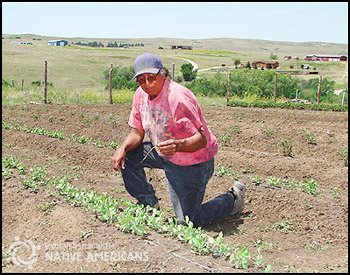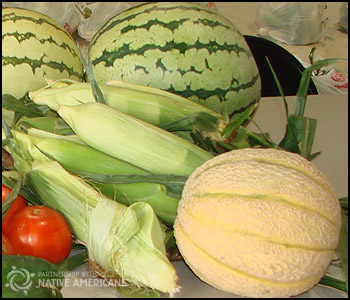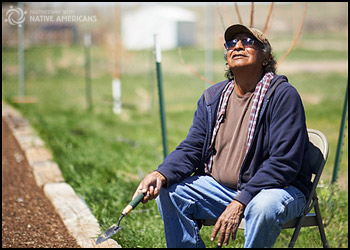Growing a Strong Community
Partnership With Native Americans (PWNA) works with hundreds of tribal communities in the Northern Plains and Southwest. The Pine Ridge Indian Reservation is part of PWNA’s Northern Plains service area but also holds the distinction of having low food security, along with other tribal communities. As a whole, the rate of food insecurity among Native American communities is higher than for the general population in the U.S. The International Relief and Development commissioned a study to examine the “double burden” of poverty: “malnutrition along with a rapid rise in obesity and diet-related chronic diseases in American Indians. Although many Americans may not know it, malnutrition on reservations is comparable to malnutrition in some developing countries.”i The Community Investment Projects of Partnership With Native Americans (PWNA) support initiatives and concerns identified by PWNA’s reservation partners. Encouraging homegrown food sources to decrease diet-related diseases is just one way PWNA and tribal communities are working together to combat food insecurity. When PWNA met John Yellow Hawk several years ago, he was a volunteer at the PWNA-supported youth garden project in Kyle, South Dakota, a Pine Ridge community. After losing his wife, he needed something more to help him through his grief. He needed a project that could draw on his natural talents and redirect his energy toward helping others. He explains, “It’s no good to be alone.” John channeled that drive and approached the director of the local youth program while a community garden was in the planning stages. Eager to support an activity with the potential to change habits and lives, the people involved with the Kyle Community Garden project welcomed John with open arms and literally handed him the tools — shovels, spade and tillers — he needed to work through his grief.
The proficiency to grow and harvest food, particularly potatoes, has been handed down from grandfather to father to son. John was particularly proud of this intergenerational skill. He recalled working in a potato field south of the reservation during his youth. His father would gather up John and some other young folks to help with the harvest in the potato fields. “Hand picking and carrying 100-pound gunny sacks was not easy,” but John admitted, “we made good money and it made us stronger.” A later injury to his arm and subsequent surgery made it difficult for John to lift even 50 pounds, but his gardening prowess was still very strong. Generosity also made John strong — it is a Lakota value he embraced wholeheartedly. He had always been generous with his vegetables, as well as his time and talents. So, after a couple of years of volunteering at the community garden and attending different trainings by PWNA and other collaborators, John agreed to teach gardening classes. In addition to covering beginning gardening, he integrated his knowledge of soil, bugs and weather as it pertains to gardening on Pine Ridge. John even assisted a neighbor with a garden, who reported back to John: “Everything grew — even the weeds!” Unafraid to try out new methods for a successful harvest, one season John tried fish fertilizer, but it attracted a new type of black bugs. Another year, he planted corn and Indian corn next to each other, but they ended up pollinating. Although “that didn’t work,” he still used the dried corn as an ornament and even placed a bundle by a photo of his wife. However, John’s knowledge and hard work eventually paid off — literally. After pursuing a grant and a loan from the Community Development Financial Institution (CDFI), John expanded his food production, in hopes that the excess harvest would be sold at farmers markets. PWNA also supported John by providing garden tilling, seeds, tools and most recently a chicken coop, diversifying his food production.
Johns’ bountiful harvest moved him from “gardener to grower” and his produce is purchased at local and mobile farmers markets across the Pine Ridge Reservation. The income from his produce enabled John to repay the loan, and the produce from his garden expanded the nutritional food choices available to other community members in this food desert. According to the USDA, a rural community is a food desert if a third of its population is 10 miles or more from a large grocery store.ii Kyle is 20 miles away. A good steward of his land, John’s garden and yard reflected all the years he and his wife cared for and created an outdoor environment to be enjoyed by their children and grandchildren. This area was special, bringing the family together in both happy and sad times. John was already gearing up for another year of planting, weeding, eating, and now selling his harvest. PWNA delivered tomato and jalapeno plants to help him get off to a good start. PWNA was honored to share in John’s journey to help grow a strong community. Growing your own nutritional food sources is a good foundation for a healthy mind and body and a sold investment in food sovereignty. (2016 update: We were saddened to hear that John passed away in June 2016. We will always remember his goodness, gift for gardening and the contribution he made to his community.) i America’s Forgotten First-Malnutrition among American Indian Populations International Relief and Development. Published at http://ird.convio.net/site/PageServer? |
 John weeding in the Oyate Teca community garden in Kyle, SD (Pine Ridge)."
John weeding in the Oyate Teca community garden in Kyle, SD (Pine Ridge)."
 Fresh produce is sold at the new farmer's market in Kyle, SD."
Fresh produce is sold at the new farmer's market in Kyle, SD."
 Generosity is a Lakota value John embraced wholeheartedly."
Generosity is a Lakota value John embraced wholeheartedly."